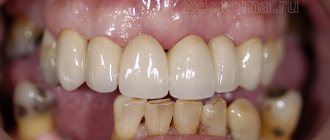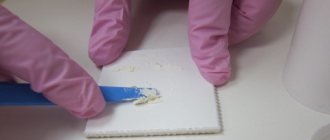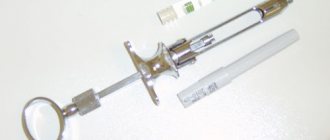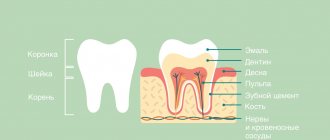- What kind of crowns are placed on teeth?
- Is it painful to grind down a tooth for a crown?
- Read more about teeth grinding
There are several reasons for using crown prosthetics.
Let us remind you that a crown is a tool for single prosthetics, which is used in the following cases: pathological pigmentation of teeth, violation of its anatomical shape, cracks, destruction of the coronal part by more than 60% of the tissue volume. To install a crown, the patient will need to go through the following steps:
- Diagnostics.
- Preparation of the tooth stump.
- Taking impressions.
- Making a crown.
- Fitting and final installation.
What kind of crowns are placed on teeth?
The following prostheses are used for dental prosthetics with crowns:
- Metal-ceramic is a budget-friendly, strong and durable crown option. The base of the prosthesis is metal, the top lining is ceramic. This ensures its strength and external aesthetics.
- All-ceramic - crowns for the front teeth are made from ceramic, since the material is not suitable for the significant chewing loads that are inherent in the lateral and chewing teeth.
- Zirconium dioxide is a premium material in modern orthopedics, used to restore both anterior and chewing teeth, as it has unsurpassed strength and naturalistic aesthetics today.
Myths about crowns, or why are patients afraid of having crowns installed?
I often see fear and disappointment on the faces of patients when the word “crown” is mentioned. And I am sure that this is not unfounded. Almost every patient of mine has either a personal bad experience, indirectly or directly related to “crowns,” or his friends or relatives have such an experience. Let's try to understand the reasons for this unsuccessful experience using the example of questions and arguments that patients use to operate.
Myth one: “Teeth decay and rot under crowns”
Yes, this happens, and patients come to me with similar problems. The reasons may be different, but they are all quite understandable.
Reason one. Teeth that were severely damaged even before prosthetics. Unfortunately, crowns are sometimes offered to a patient in cases where, according to modern treatment protocols, it is time to remove a decayed tooth. Hence the problems - if a tooth is critically damaged by life, then the crown is only the final chord, which often does not last long. If a tooth is destroyed to the level of the gum (or under the gum), and there is no way to improve this situation, it is better to replace such a tooth with an implant while there is enough bone tissue around.
Reason two. Poor hygiene. If this is the cause of the destruction of healthy teeth, then no crown will save a weakened tooth from the effects of microorganisms.
Reason three. Neglect by the doctor of such an important clinical stage as the manufacture of intermediate crowns. People also call them “temporary”. For modern doctors, the stage of making “temporary” crowns is inextricably linked with the making of permanent ones. If you neglect it, problems may arise.
Reason four. Poor quality crowns that do not fit well to the tooth. When there is a large gap between the tooth and the crown, this will not lead to anything good. Plaque accumulates in the cracks, an unpleasant odor appears in these areas, and the gums begin to become inflamed.
Here is one example of a tooth being removed due to a huge gap formed by the edge of an old metal crown.
If desired, one could stick a finger into this gap. Now compare the fit of the old metal crown with this photo:
The crown-tooth boundary, even with high magnification, is visible only by the color transition. The microscopic gap is securely closed with fixing cement, like a sealant. This is the kind of fit that any modern crown should strive for.
Myth two: “The tooth needs to be ground down heavily for a crown.”
This is not entirely true. Currently, in modern dentistry it is customary to preserve tooth tissue as much as possible, as this improves the prognosis of restoration. Using magnification - an operating microscope and binoculars - the doctor has very good control over how much tooth tissue he removed during treatment. As a rule, for a modern design it is enough to remove 0.6-0.9 millimeters of tissue, depending on the clinical situation, and an adequate doctor always strives for these values.
In this photo there were 2 teeth side by side with different approaches to treatment for crowns. On the right is a tooth cut down excessively (the thickness of the removed tissue is about 2 mm), on the left is a tooth processed using magnification (the thickness of the removed tissue is 0.4-0.6 mm). Modern materials (metal-free ceramics) and magnification tools allow dentists to treat teeth 3-4 times more carefully. And this significantly affects their service life.
Myth three: “If anything happens, after the crown the only thing is removal.”
Let's look at the previous paragraph. If the boundary between the edge of the crown and the tooth is above the gum, if the grinding was done carefully under magnification, then re-prosthetizing such a tooth even after a long time is not a problem. If the tooth is destroyed even before prosthetics, then there is really nothing to hope for.
Myth four: “Teeth under crowns must be depulped (the nerve removed) and pins placed.”
This is an inveterate myth, which, unfortunately, is still reinforced by many dentists. I can only say that with the use of modern equipment, cooling, adequate temporary prosthetics and careful hands, it is possible to work on vital - “living” - teeth without any problems. But often it is not necessary to cover such teeth with a full crown - it is enough to make an inlay.
These four myths are often the most important arguments of patients “against” dental restoration with crowns. What happens when patients choose a “filling” instead of a crown, arguing that “if it falls out, I’ll put a new one”? A few photos will answer best:
And the reason for such fractures is that the load on the tooth is very serious, and many, including some dentists, do not take this into account. The crown allows you to distribute the chewing load more evenly and safely over the remaining part of the tooth, without leading to chipping of the walls. Whether it is worth risking a tooth and preferring a large composite filling to a durable, properly made ceramic crown, everyone decides for themselves.
And now I would like to give an example of work according to modern indications. The patient underwent endodontic treatment of the root canals of tooth 4.6 due to irreversible pulpitis, then a decision was made to make an indirect all-ceramic restoration (crown).
The “core” of the tooth was restored and it was prepared for a full crown:
View of the finished restoration in the oral cavity after a few weeks:
PS So, is the word “crown” really a death sentence for a tooth? In my opinion - no! And with my article I tried to prove this with examples. The procedure for making a crown in modern dentistry is a high-tech event aimed at preserving the tooth and its further long-term functioning. The use of water cooling during preparation and a rubber dam make the procedure quite comfortable for the patient. The doctor's use of magnification allows maximum control over the preparation process. And such a novelty as digital impressions saves the patient from what is perhaps the most unpleasant procedure in prosthetics. In the right hands, an indirect restoration (crown or inlay) can help protect the tooth from fracture. If they are wrong, they lead to problems and disappointments, which give rise to many myths. So, dear patients, choose your doctor carefully! Good luck to everyone!
Author of the article: Pavel Pola
Authors of photos of clinical cases: Pavel Pola and Kirill Kostin
What is meant?
Metal ceramics – two-layer prosthesis. The bottom layer is metal, the top layer is ceramic lining. In any case, such a product cannot be “thin”. This means that in order for the artificial tooth to be the ideal size, the stump will have to be considerably ground. In most cases, preparation will require depulpation of the nerve. Naturally, all this is done under local anesthesia, and the patient does not feel pain. Let us immediately note that while the dental technicians are making the prosthesis, the doctor will cover the ground tooth with a temporary “cap” in order to avoid hyperesthesia, a reaction to cold or hot.
Zirconium is not only the most durable and beautiful, but also the thinnest prosthesis. To install a zirconium dioxide crown, the tooth can be ground only slightly. In most cases, pulp preparation is not required. Many patients refuse anesthesia because there is no pain during the process of removing the top layer of enamel. If a person has a low pain threshold, then doctors use local or topical anesthesia so that the person feels physically and emotionally comfortable.
The thickness of the ceramic crown is average - between “thick” metal ceramics and “thin” zirconium. This means that the degree of grinding, and as a result, the level of trauma of the procedure, is determined individually in each specific case.
Author:
Mayorov Andrey Mikhailovich
Specialization:
orthopedic dentistry, dental prosthetics, implant installation
When is a doctor needed?
If your teeth ache for longer than 7 days after grinding, you should make an appointment with your doctor. The reason for contacting a specialist may also be:
- inflammation and bleeding of gums,
- the appearance of neoplasms on the mucous membrane,
- bad breath,
- pain when chewing and brushing teeth.
The listed symptoms cannot be ignored. Even with minor discomfort, it is better to consult a doctor to exclude the development of serious diseases.
Examples of work “Before” and “After”
Express dental implantation ROOTT on the lower jaw
Case: periodontitis, severe root exposure, bone atrophy, as well as a high degree of tooth mobility in the lower jaw.
Express implantation ROOTT and removable prosthetics
Case: partial edentulism of the upper and lower jaws, periodontitis in the lower jaw, severe atrophy of bone tissue, mobility of teeth.
Expert opinion
Emir Romanovich Omerelli
Maxillofacial surgeon, implantologist
Experience: more than 13 years
By grinding the abutment teeth to secure the bridge, you will inevitably shorten their service life. How quickly they deteriorate and require replacement is an individual matter, but removing a layer of living tissue is not beneficial in any case. If there are no contraindications to implantation, it is better to install artificial roots and attach a bridge to them. At the same time, you do not harm healthy teeth and receive a guarantee of long-term trouble-free operation of the prosthesis.
What methods of hard tissue preparation exist?
Despite the development of progressive technologies, today in dental practice doctors carry out the preparation of hard tissues in 99% of all cases using a conventional drill and a diamond tip mounted on it. The procedure is similar to drilling out caries. Less commonly used are laser or ultrasonic methods, as well as air abrasive and chemical methods - all of them are applicable only if it is necessary to remove a minimum amount of tissue, but bur is suitable for any clinical situations.
Structures with interlocking connections
For prosthetics of one or two teeth without turning adjacent units, the CBW prosthetic system can be used. Its features:
- Small canals with a diameter of about 1 mm and a length of 1.5-2 mm are formed on the lateral parts of the supporting teeth.
- Locks made of titanium or zirconium are inserted into these microcavities and secured with glue.
- The intermediate part of the prosthesis is fixed with installed locks.
This method makes it possible to save adjacent teeth, but it is more often used as a temporary option, since CBW systems cannot be called durable.
Adhesive prostheses
This is a relatively new technique for restoring the integrity of the dentition with minimal preparation of supporting units. At the same time, the latter are not depulped, that is, they remain “alive”. And they are not covered with artificial crowns. To install an adhesive prosthesis:
- Shallow grooves are sawed on the teeth adjacent to the defect;
- a prosthesis on a beam is installed in the prepared “niches”;
- From above, the fixation site is covered with composite materials.
Adhesive prosthetics is a progressive and affordable alternative to the installation of metal-ceramic bridge structures. One of its advantages is the ease of replacing such a system if the patient desires to choose a different method of dentition restoration.
Sign up for installation of dental inlays at a discount:
What is a tooth core?
Stump inlays are structures that enter one third of the tooth canal, restoring the lost part of the tooth from above. A crown is installed on top of the stump inlay, which is made from the material chosen by the patient.
Often there are teeth restored with “extended” fillings on pins. It should be noted here that some dentists install huge fillings on their patients’ posts instead of crowns. Such fillings do not last very long, and they fall out even if you do not chew anything hard. As a result of chewing, this huge filling, together with the pin, goes sideways and breaks the root of the tooth in which the pin was installed. Such a root usually has to be removed. In rare cases, it is possible to install a crown on a broken tooth. This usually happens in cases where the crack is not below the level of the gum.
How long have dental inlays been used on the Russian dental market?
Quite a long time ago, more than 10 years. It’s just that not all patients agree to visit the doctor several times. They want to do everything in one day, so they choose large fillings, fillings on pins (“extended”). Some doctors make concessions to such patients and do as the patients want, but this is wrong. A healed tooth with a large filling will simply chip quickly, and there is a chance of losing the tooth altogether, so it is better to put an inlay on it.
How many tabs have you installed as a specialist?
Hard to say. I've been working with tabs for about five years. We install 10-15 tabs per month. There are patients who need to install several inlays at once, for example, due to increased tooth wear.
Let's summarize our conversation. What is better - an inlay, a crown or a filling?
Everything is done according to indications, but, of course, a ceramic dental inlay is best.
Let me give you an example: I had patients who had a ceramic inlay installed on one side and a metal-ceramic crown on the other. And according to reviews, the inlay is much better, since most often food gets under metal-ceramic crowns and accumulates under them. This may cause an unpleasant odor.
If metal-ceramic crowns were installed, the metal edge may be exposed, which does not add aesthetics.
Patients also do not like large fillings, which shrink after a certain time, and there is a high probability of chipping the tooth wall or caries.
In these cases, tabs are the best option.
Doctor, thank you for the detailed story!











